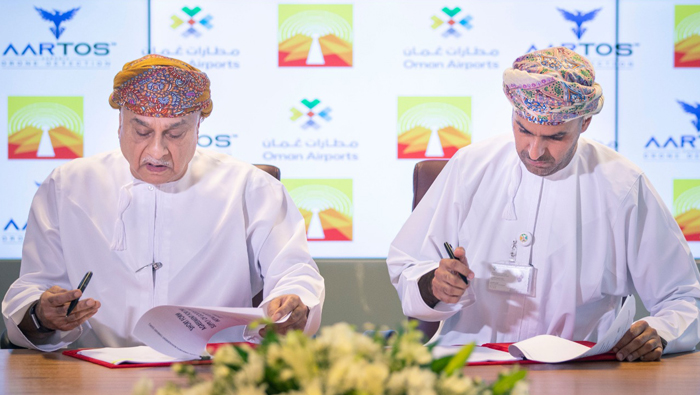
Muscat: Oman Airports has signed an agreement to install a drone detection system at Muscat International Airport, making it the first in the world to have such a setup.
The agreement was signed on Sunday, 14 July 2019, in collaboration with the German company Aaronia AG and R&N Khimji LLC, who will supply and install the latest drone detection system.
The agreement was signed by Aimen bin Ahmed Al Hosni, Chief Executive Officer of Oman Airports and Ramesh Khimji from Aaronia AG in partnership with R&N Khimji LLC.
**media[1042901]**
Aimen Al Hosni, Chief Executive Officer of Oman Airports stated: “The system is able to detect drones and other devices using radio frequency to protect the surrounding areas of the airport including the landing and take-off runways. The system can detect multiple drones and other devices at various frequencies simultaneously and comes equipped with sophisticated long-range cameras for additional verification. Aaronia has been working with high-end radio frequency (RF) and microwave systems for over 15 years with all software and hardware being developed in Germany.”
“With the confirmation of the procurement of the system, Muscat International Airport will be the first International Airport in the world to use this technology and to have an operational drone detection system. We are pleased, at Oman Airports, as one of the subsidiaries of Oman Aviation Group, to be actively engaged in attracting world-class cutting-edge technologies.”
Speaking exclusively to Times of Oman, Aaditya Khimji, Managing Director, R&N Khimji said the detection system is an endorsement of Oman being a progressive country.
“Our group operates under the guidance of His Majesty’s vision to enable connectivity in the Sultanate,” he explained. “From our beginnings in the civil construction industry to the present where we focus on critical communications, we aim to serve our country in seeking optimal and efficient solutions that are required for safety and connectivity.”
“We are proud to support Oman Airports’ goal in being a leader in the global aviation industry by deploying this state-of-the-art system at Muscat International Airport. We are showing the world that we are progressive, by being the first to act in protecting our airport environment from a relatively new threat to flight safety,” Khimji said.
Describing how the system was going to help and benefit the people in the Sultanate, he said: “We currently have no way of knowing when someone with no ill intention is flying their drone within the airspace.
There have been studies where a collision between an aircraft and simple drone costing a few hundred Rials can have catastrophic consequences.”
“Our system will not only tell the authorities if there is a drone but whether or not it is in the flight path and where the operator is. This will bring us a step closer to regulating drones and allowing all of us to gain the benefits of owning a drone without the authorities fearing them,” Khimji added.
After signing this agreement, Muscat International Airport will be one of the world leading airports, equipped with the latest and most sophisticated equipment that enhances air navigation and contributes to safe and secure landing and take-off activities. This is in line with their aim to ensure the highest degree of safety for passengers and airlines using Oman’s airports.
Vital requirement
“Drone detection in airports has become a vital requirement with several instances causing disruption of airport services around the world. At Oman Airports, we seek to use the latest systems and technologies to ensure the highest standards of safety. The limitation of most systems using Radar technology is that they cause interference with existing airport systems and have a low detection rate. Aaronia’s unique solution, offered today at our airport, uses the latest RF detection technologies and emits no signals, therefore cannot interfere with other systems running in our airports,” Al Hosni said.
He continued : “Oman Airports is continuously searching for optimal solutions to enhance our capabilities and the work environment at our airports in the Sultanate. The system that we are going to install at Muscat International Airport can detect the location of the operator of the drone, which allows immediate coordination with the competent authorities to address any situation.”
Although drones are generally regarded as safe, several instances have been reported in which they have threatened air traffic and caused disruption of airport and flight services around the world, resulting in flight delays and travel inconvenience for thousands of passengers, in addition to the security risk that it presents to safe travel.
The Middle East region is witnessing rapid growth and developments that require civil aviation operators to address a range of safety-related challenges at various levels, particularly amidst the increasing demand for air routes and the higher levels of aircraft traffic and more widespread use of drones.
Drones pose a potential security threat to many facilities, including airports, power facilities and security-sensitive locations. Some drones can fly for weeks or months at high altitudes and can reach up to six kilometres. Some drones are designed to be palm-sized or smaller which make them hard to tracked or detect.